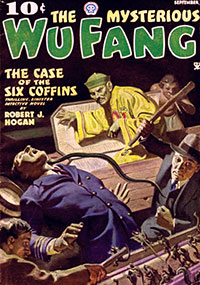 Creating a series staring the villain is hard, but it has been done. Fu Manchu, by Sax Rohmer, is probably the most well-known. He appeared in over a dozen novels for about 50 years.
Creating a series staring the villain is hard, but it has been done. Fu Manchu, by Sax Rohmer, is probably the most well-known. He appeared in over a dozen novels for about 50 years.
More successful is the French character Fantomas, who ran 32 volumes over a couple of years by two authors (they were doing a new novel every month!), then another 10 novels over 25 years by one of them.
And both of those characters have spawned movie and comics versions of their stories, and a slew of copycats.
But in the pulps, while hero pulps were very successful, attempts at series starring a villain weren’t so successful. A pair of them modeled on Fu Manchu didn’t get a dozen stories total.
The Mysterious Wu Fang was launched in September 1935. Written by Robert J. Hogan, who had created G-8 and many other series for Popular Publications, usually air war ones. The series “starred” the sinister oriental villain, Wu Fang. While one could look at Fu Manchu as someone wanting to liberate Asia from the West, Wu Fang was just motivated by the joy of killing and wanted to rule the world.
He was opposed by Val Kildare, a Federal agent, and Jerry Hazard, a correspondent for a newspaper. There was also a girl, Mohara, who was associated with Wu Fang, but fell in love and married Val. They filled in the slots for Denis Nayland Smith, Dr. Petrie, and Kâramanèh (who married Petrie).
The series ran a total of seven issues until March 1936. There was apparently continuity from issue to issue. The stories included:
- “The Case of the Six Coffins, (September 1935)
- “The Case of the Scarlet Feather, (October 1935)
- “The Case of the Yellow Mask, (November 1935)
- “The Case of the Suicide Tomb, (December 1935)
- “The Case of the Green Death, (January 1936)
- “The Case of the Black Lotus, (February 1936)
- “The Case of the Hidden Scourge, (March 1936)
I had heard that the Sax Rohmer estate had issues with the title of the series, claiming it was too close to “Fu Manchu,” and so the series was canceled. Can any confirm/deny this?
However, in May 1936, just two months later, a new series with an oriental villain came out: Dr. Yen Sin. And it seems to be using the cover artwork (by Jerome Rozen) planned for the next issue of The Mysterious Wu Fang as well. The series was written by Donald Keyhoe, who had been writing several air war series for Ace (Philip Strange, Eric Trent, Richard Knight, Devil Dog Squadron) and Popular (Vanished Legion, Jailbird Flight).
Dr. Yen Sin is a sinister Chinese crime lord and head of the Invisible Empire aiming for world conquest. He is opposed by Michael Traile, a different hero like Keyhoe’s Strange and Knight. Due to a childhood accident and botched operation, he can’t sleep and must meditate each day. He is aided by Eric Gordon, a Department of Justice agent. And there is a girl, Sonia Damitri. (Yep, a similar group of characters.)
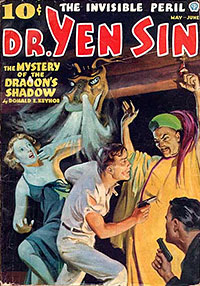 Sadly, the series lasted only three issues until September/October 1936. (so the two series lasted a year in total.) The stories included:
Sadly, the series lasted only three issues until September/October 1936. (so the two series lasted a year in total.) The stories included:
- “The Mystery of the Dragon’s Shadow” (May/June 1936)
- “The Mystery of the Golden Skull” (July/August 1936)
- “The Mystery of the Singing Mummies” (September/October 1936)
Of the two series, I found Yen Sin much more interesting then Wu Fang. Traile is a much more original hero. I also found it interesting that Keyhoe did a better job than Hogan at an oriental villain. Keyhoe also did a better job of doing a WWI ace fighting a bizarre war in Philip Strange than Hogan’s G-8. I think G-8’s popularity is because most pulp fans just aren’t that aware of Strange, plus G-8 had his own series while Strange shared Flying Aces with a half dozen other series. I know I wasn’t aware of him until Age of Aces started to reprint his stories.
The two series are a little hard to find. Robert Weinberg reprinted the first issues of each series in his Pulp Classics series (#8 and #9) in 1975 with new covers by Frank Hamilton. Except for the last issue of Wu Fang, the rest of the two series were reprinted in Adventure House‘s High Adventure. Girasol Collectibles has reprinted both series in their pulp facsimile series. I really wish someone (Altus Press?) would reprint the two series complete in book form.

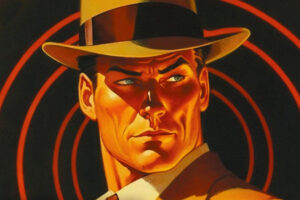
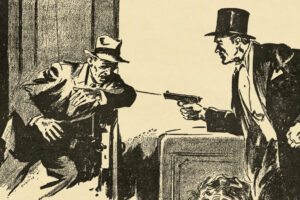
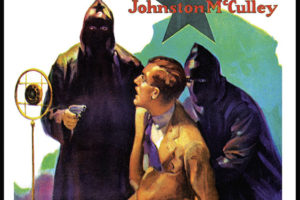
Aviation pulp author Donald Keyhoe went on to become a leading light (*ahem*) in Ufology. Given his previous body of work, one has to wonder whether he believed what he wrote in “Flying Saucers Are Real” (Jan 1950) or was just writing to a target audience as he had in the pulps.
https://en.wikipedia.org/wiki/Donald_Keyhoe
More then a leading light, as he was head of the main UFO group for many years.
I haven’t, as yet, dug into his several other pulp aviation heroes. Hope to soon.
I’ve always felt that the big weakness of the bad guy pulps was that they fought the same heroes, all the time. Dr. Satan, Fantomas, Yin & Wu were that way. Fu almost always opposed Nayland Smith, but Smith’s associates varied somewhat.
Ironically, no Asian hero stood against the “Yellow Peril.” That is until the 1950’s when Stan Lee created FBI Agent Jimmy Woo to take on the Yellow Claw.
{shameless self-promotion} A few years ago, almost by accident, I created a villain pulp. The Sons of Thor are rabid Germanic nationalists who believe Thor and the Norse Gods back them. They think the Nazis are newcomer wimps. I told a World War One story about them and the very green 2nd Lt. Richard Curtis Van Loan. Of course Van Loan became the Phantom Detective and fought them in the 1930’s. Then came their planet-wide threat Jim Anthony dealt with. Finally everybody teamed up with the Black Bat to thwart the Sons’ master plan. “Sons of Thor” appeared in the April & May 2012 issues of Pro Se Presents. The books are available on Amazon, or from me. erwin dot k dot roberts at gmail dot com. {/end Shameless self-promotion}
Actually, I reviewed the Sons of Thor in a earlier blog posting.